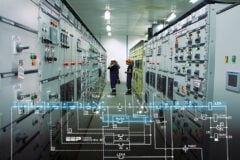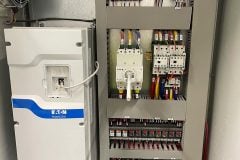
Introduction
In modern plants, there are number of drives like Milling Plant Drive, Hydraulic Drive, DC Motor Drive and AC Motor Drive of adequate capacities are available. There is lot of scope for improving the overall efficiency and saving the energy consumption.
One of the ways is by installing VFD Drives to A.C motors. This has been discussed below.
Abstract
- General requirement of speed variation in the drives
- Types of system to vary the speed
- Types of AC VFD
- Previling practice of speed variation in Sugar & Allied Industries
- Increase in VFD Drives in Sugar & Allied Industries
- Economics of the system etc., are discussed in this article.

General requirement of Speed variation drives
Variable speed drive equipments shall be compatible with the equipment it serves.
Further, the drives shall be capable of converting the fixed input speed from the specified motor to variable output speed indicated in the driven motor and they shall also be capable of varying the speed on demand with smooth acceleration and deceleration with out any vibration.
Acceleration function shall be a straight line relationship with time. As informed earlier, by introducing Variable Frequency Drives in electrical circuit this can be achieved.
Systems available to vary the Speed
A VFD is basically an electrical circuit, which is connected between a supplying network and a motor.
In general, a state-of-the-art VFD consists of a rectifier section, a DC-link section and an inverter section. The rectifier section rectifies the supplying AC network voltage of fixed frequency (usually 50 or 60Hz) into a DC voltage / DC current, which then, in the inverter section of the VFD, will be transformed into an AC voltage / AC current of variable amplitude and frequency.
Types variable frequency systems available
A. Low voltage drives
B. Medium voltage drives /in tommorow’s article/
C. High voltage drives /in tommorow’s article/
When talking about Variable Frequency Drives (VFDs), one has to distinguish between Low Voltage VFDs (up to 690V motor voltage) and Medium Voltage VFDs (above 1kV motor voltage).
Typically the economically reasonable power ranges are:
- for LV-VFDs is up to 500 Hp
- for MV-VFDs is upto 1000 Hp and
- for HT VFDs is above 1000 H.P . This system is to reduce THD and transmission loss.
A. Application of LV VFDs In Sugar Industry
Introduction
Inially LV-VFDs were introduced into the market in the late 60’s only… The benefits of LV-VFDs in those days were basically the same as today ie. energy savings, improved process control, less maintenance cost.
These problems have now been basically eliminated allowing the advantages of a LV-VFD system to clearly dominate. This opened the doors for LV-VFDs to enter in many industries such as oil & gas petrochemical, power, water & sewage water pumping, metals, minerals & mining, marine and Sugar plant etc to name just a few.
This is mainly for the controlled and economical transport of liquids, gas and solid.
In the sugar industry, a lot of applications are suited for operation with a LV-VFD instead of the conventional driving methods such as:
- Cane Carrier Drive,
- Feeder Table Drive,
- Milling Plant Drive,
- Raw juice Pumps,
- Sulphited Juice Pumps,
- Molasses Pumps,
- Injection Pumps,
- Cooling Tower Pumps and
- Centrifugals for a Sugar Curing and Chemical Dosing pump.

Inially LV-VFDs were introduced into the market in the late 60’s only.. The benefits of LV-VFDs in those days were basically the same as today ie. energy savings, improved process control, less maintenance cost.
However, these benefits were to some extent, compensated by the drawbacks such as low power factor issues, harmonic distortion, torque pulsations and reliability problems. These problems have now been basically eliminated allowing the advantages of a LV-VFD system to clearly dominate.
This opened the doors for LV-VFDs to enter in many industries such as oil & gas petrochemical, power, water & sewage water pumping, metals, minerals & mining, marine and Sugar plant etc to name just a few. This is mainly for the controlled and economical transport of liquids, gas and solid.
Applications
a. Pump applications
The sugar industry in particular uses pumps for transferring liquor with:
- Controlled flow rate,
- Controlled pressure,
- Controlled level in the vessel.
Besides the transfer of liquor, pumps are also used in power generation to feed water to the boiler.
Using VFDs for such applications contributes to very high energy saving potential, making it the most economical and efficient method available as of today.
b. Conveyor applications
VFDs can be used to control the speed and torque of belt conveyors, resulting in easy management and very precise control.
c. ID and FD fan applications
Sugar plants use boilers to generate high-pressure steam for Electrical Power Generation and low pressure steam for heat exchangers. Since the steam consumption varies depending on the demand, the boiler has to accommodate this variation by controlling the fuel and air.
In order to achieve this with better performance and remarkable energy savings, VFDs are used for the control of Induced Draft (ID) and Forced Draft (FD) fans in Boiler area…
d. Centrifuge applications
VFDs can also be applied in centrifuge applications which is the heart of sugar refining for the batch centrifugal speed control.
In this application, the use of VFDs with common DC bus is also the most reliable and efficient control method, contributing to minimum electrical equipment installations, lowest energy consumption and almost negligible impact on the power grid.
e. Low maintenance
The required maintenance is more or less limited to exchanging (intervals depending on the ambient conditions) a few items such as the air filter in the case of an air-cooled drive or as the de-ionizer vessel in the case of a water-cooled version or the back-up battery .
Benefits of LV-VFD systems
a. Energy savings
VFDs offer a wide range of benefits such as improving the quality of a product by having a better control of the process and, due to an optimal pressure or flow control, substantial energy savings.
b. Minimized maintenance
By replacing mechanical components such as valves, dampers and gas/steam turbines with electrical equipment, i.e. a LV-VFD system, the maintenance efforts will be minimized. A reliable and well-designed VFD system will be sufficient with a minimum Operating time and maintenance.Further the system do not require any major component replacements within the first ten years.
Although it is recommended to have a regular maintenance schedule, many of these checks can be done while the drive system is in operation, which will avoid a process shutdown.
c. Improved process control performance
Compared to mechanical solutions such as damper/throttle/ vane on/off- or pitch control, LVVFDs provide a much smoother and more accurate way of controlling a process. With a LV-VFD system, Speed and torque can be adjusted and maintained with accuracies of 0.1% and better. As a result, depending on the application, the process is controlled in a more efficient way and the process output is of better quality.
Other benefits include a lower system noise level and the integrated motor protection equipment, which is part of the VFD scope of supply.
d. Extended lifetime of motor and mechanical equipment
Due to the availability of smooth soft-start capabilities , wide range adjustable speed and torque control capabilities of a LV-VFD system, the lifetime of the motor and the driven mechanical equipment will be extended.
For example, due to the reduced pressure at partial load, the lifetime of pipes and other components is increased. By applying a VFD system, vibrations can be reduced which increases the lifetime of the equipment.
e. Elimination of motor inrush currents
The high inrush currents can exceed 5-7 times of the nominal motor current with DOL start up.This will be eliminated with a LV-VFD system.
Especially in applications with high inertias (e.g. fans), high inrush currents may result in a considerable overdesign of the motor due to the extended acceleration times at high inrush currents, which increases the price of the motor. With a LV-VFD system, the start-up is extremely soft, and the currents on both the line supply side and the motor side will not exceed their nominal values during start-up.
It should be stressed at this point that a start-up with a so-called soft-starter would not result in the same low motor current values as in a start-up with a VFD system. Although significantly reduced compared to DOL starting, the inrush currents still remarkably exceed the nominal motor current values when soft starters are applied.
Improved immunity against supply disturbances
Typically, disturbances in the supplying network such as:
- Transient spikes
- Unbalance
- Voltage dips lasting over a few cycles
- Frequency deviations or, most severe, interrupts will have an impact on the performance of a DOL operated motor.
Especially voltage dips above a certain magnitude (typically >10%) will instantly result in a reduced output power or a complete loss of the driven process.
With a MV-VFD system, “ride through” capabilities will ensure that the process will not at all or to a reduced amount be affected by supply disturbances of the kind mentioned above.
Also a short circuit in a DOL-operated motor will have a remarkable negative impact on the supplying network. With a VFD between the network and the motor, these short circuits are handled by the VFD system in a very fast manner and will have a minimum impact on the supply system.
To be continued tommorow…











Ingenieros EEP, cordial saludo desde Pereira Colombia, mi nombre es Diego Valencia Serrato ingeniero Electricista contratista externo en la industria colombiana. Hoy elevo una consulta a ustedes correspondiente a la siguiente inquietud:
El equipo de medida TTR marca Biddle modelo 550005 brinda las condiciones para realizar la medición del Desfase Angular (en grados), de manera Trifásica sobre Transformadores Desfasadores empleados para alimentación de Variadores de Frecuencia de 24 pulsos, donde los desfases son de tipo irregular (-22.5°, -7.5°, +7.5°, +22.5°).
Al igual agradezco la referencia del o de los equipos que bien puedan garantizar que esta prueba se realice en forma adecuada. Así como la metodología que se debe tener presente durante la prueba o medida del desplazamiento angular irregular.
En nuestro caso tenemos un Transformador desfasador tipo seco clase H de 24 pulsos conexión Y Primario y Delta secundario (4 devanados) de 2 MVA relación 13.200/(4×1.110) voltios.
Agradezco a los colegas que bien puedan aportar sobre la consulta.
Diego Valencia serrato
Ing. Electricista UTP
Contratista Externo
Pereira Colombia
Cel 315048039058
dvs.servingenierias@gmail.com
—
Thank you so much for making available these wonderful professional materials free on your website. Appreciated the contributors’ sincerity and enthusiasm in sharing the knowledge with the curious learners.
While talking about Sugar Cane Industry, the reference to fluid transfer it was seen written “liquor”. Was it correctly meant or a typo for “liquid”.
Thank you once again.
Pal
what are the difficulties come when a HT motor (3.3kV, 6.6kV & 11kV supply) is used as a LT motor (415V supply)?
Please send more details about part 2 / part 3 for MEDIUM VOLTAGE / HIGH VOLTAGE INVERTERS
Please can you tell us more about VFD systems design.
Please give me clarification about what are high efficiency motor ? what are technical reason for getting high efficiency ?why we going to choose the high efficency motor ?
How to size the cable from Vfd panel to motor. It should be 3C or 4C.
must appreciate the authors of this website.. hats off……
Thank you Khurrambughio, glad you like it!